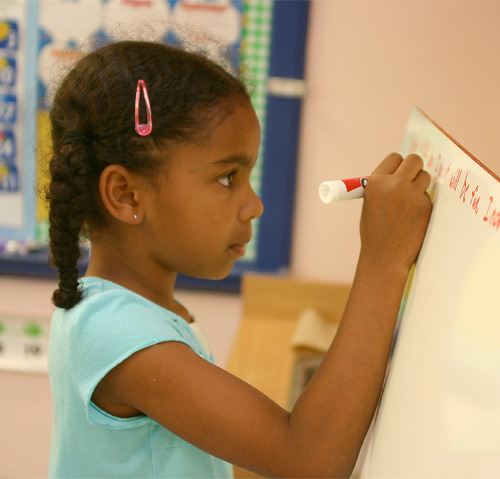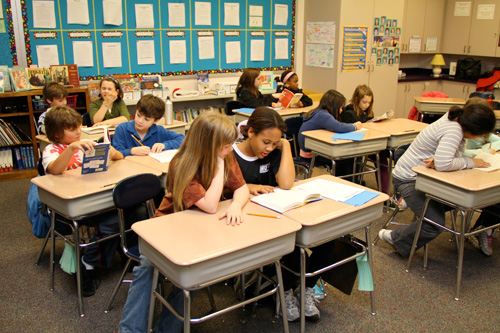What are some general instructional practices that can be beneficial to students who are learning to speak English?
Page 9: Differentiate Instruction
 Another way to support English learners is to differentiate instruction. Rather than expect students to adjust to the curriculum, teachers should adjust their instruction to meet the individual language and learning needs of their students. This requires teachers to provide options in the ways they:
Another way to support English learners is to differentiate instruction. Rather than expect students to adjust to the curriculum, teachers should adjust their instruction to meet the individual language and learning needs of their students. This requires teachers to provide options in the ways they:
- Present information or allow students to access information.
- Example: During a science lesson about the solar system, the teacher uses visuals, hands-on materials, and kinesthetic activities to explain concepts such as rotation and revolution. The teacher also has books and videos in Spanish that the students can access, if needed.
- Encourage students to make sense of the information.
- Example: To help students process information about the solar system, the teacher sets up a learning center. There, some students focus on that main learning goal (e.g., learning the names of the planets), while students who quickly master the main learning goal are able to engage in high-order learning activities (e.g., learning about the key features of the planets). Some students may work with their peers and practice the learning goal while using their home language.
- Allow students to demonstrate their learning.
- Example: To demonstrate their learning, students have the option of creating a model of the planets, making a poster, or writing a report.

Teachers can differentiate instruction by being flexible in the ways in which they:
Present information or allow students to access information:
- Provide a range of choices to access the content (e.g., books, audio, and video in student’s home language and in English.
- Make instruction more concrete by using pictures, charts, realia, demonstrations, graphic organizers, or timelines.
- Model lab procedures and include visual references about concepts.
- Provide texts at different reading levels.
realia
glossary
Encourage students to make sense of the information:
- Provide a range of choices for student to practice what they are learning.
- Use flexible grouping.
- Use hands-on activities
- Set up classrooms with learning centers (e.g., make available audiotapes and CDs to assist students with their reading).
- Provide materials in different languages.
flexible grouping
Grouping students into smaller groups or pairs, homogeneously (e.g., by ability, interest, learning preferences, or language needs) or heterogeneously. The benefits of flexible grouping include:
 Interacting with peers who speak English and who are good language models
Interacting with peers who speak English and who are good language models- Helping to translate material for students who may be less proficient in English
- Giving ELs a feeling of empowerment when they discuss their assigned tasks
- Allowing students to experience interethnic group interactions
- Increasing friendships
- Gaining higher levels of confidence
- Receiving additional instruction
- Allowing opportunities to practice academic language
Research has found that across ethnic, gender, and ability groups, students have shown gains in academic outcomes when working in collaborative small groups—in part because collaborative problem solving may be highly valued at home, and in part because students are validated by their peers when speaking either Spanish or English.
Allow students to demonstrate their learning:
- Offer a range of choices to express understanding (i.e., create a slide presentation, write a song or poem, stage a performance ).
- Permit the option to work independently or in a group to complete an assignment.

Example: Ms. Westerman collaborates with the bilingual teacher about her upcoming lesson on rocks and minerals. In this way, the bilingual teacher can pre-teach some of the vocabulary terms by using pictures, charts and graphic organizers for the students who receive bilingual education. Later during whole-group instruction, Ms. Westerman displays images used by the bilingual education teacher. Every rock or mineral vocabulary term that appears on the screen is labeled in both English and Spanish. Later, the students work in small groups to complete a hands-on activity to better understand what has been presented.
Listen as Janette Klingner talks about the benefit of grouping for ELs (time: 0:35).

Janette Klingner, PhD
School of Education
University of Colorado, Boulder
Transcript: Janette Klingner, PhD
In their small groups, they are supporting one another because they’re working in a less-threatening situation in a small group with their peers that is going to reduce how demanding the task is. Students are able to get support from one another and talk about what they’re learning, work through some of the challenging aspects of a text they’re reading together. That can help teachers reduce the cognitive load and provide more context for students so they can be successful.